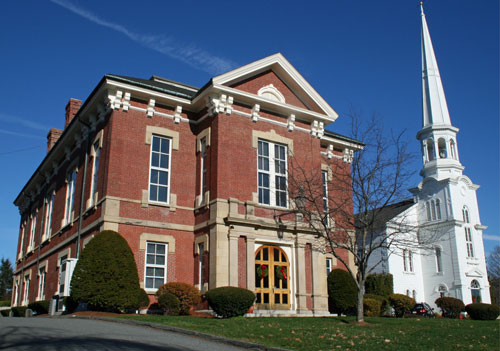This is the latest in an ongoing series about historic places in Southborough. The information all comes from a survey of historic properties done in 2000. To see other posts in the series, click here.

Aside from the font doors which were replaced in the late twentieth century, the facade of the Town House is much the same as it was when it was built in 1870.
We tend to think of the Town House now as being all business. You go there to pay your water bill, or to register to vote, or (if you’re like me) to attend any number of town committee and board meetings. But it didn’t always used to be that way.
The Town House was built in 1870. It replaced a smaller wood-framed town hall built in 1840 after that building was destroyed by a fire in 1869. Southborough benefactor Joseph Burnett made a large donation to the building fund and hand-picked acclaimed Framingham architect Alexander Esty to design it. Esty had designed neighboring St. Mark’s Church several years earlier.
When it opened in the spring of 1870, the Town House had all the modern conveniences, including gas lights and indoor plumbing. The main meeting hall occupied to upper floor, while the lower floor was divided into several spaces including a smaller hall, Selectmen’s room, and the Fay Library.
The large upper hall was the site of town meetings, which you might expect, but it also hosted social gatherings and theatrical performances. It was rented out for concerts, lectures, exhibitions, parties, and the occasional ball. Balls brought in the most revenue for the town. They rented the space for $20 per evening from 8:00 pm to 1:00 am, and then $5 per hour after that.
The smaller hall on the first floor was similarly rented out for parties, lectures, exhibits, and a dancing school. It was also used by the Southborough Farmers’ Club.
The building had a piano, and in the early 1920s, the Farmers’ Club sponsored silent movies in the upper hall with local musicians accompanying the movie on the piano.
In 1892 President Grover Cleveland gave a torchlight speech in front of the Town House during his reelection campaign.
Over the course of the twentieth century, the Town House was gradually subdivided into the municipal office space we know today, and the social nexus of the town migrated east to the Community House.
I’m not sure when exactly the Town House adopted the configuration it has today, but I’ve heard that some longtime residents remember a time when the upper hall was used as a gym for basketball and other sports. There’s no mention of that in the historic survey. Anyone remember those days?


A couple of notes about the Town House and its uses and history.
There are a number of residents who remember basketball games and plays in the upper hall. They are among people I’m interviewing for an oral history to be published in 2010 by the Historical Society. I remember election nights in the middle 1970s when the votes were still counted by hand in the upper hall with electric lights strung across the hall to give enough light to see. One Democratic Primary with at least six candidates (I think when Congressman Harold Donohue decided not to run) held the workers there counting until 6 a.m., as I, a dutiful reporter for the Middlesex News, stayed with them, awaiting the results.
After the typical multi-year debate at Town Meetings, in 1978 the Town House underwent a major renovation to its present configuration with the new entrance and elevator on the parking lot side, smaller offices opened up on the first floor, and the main meeting room on the second floor (no more third floor/balcony). Town offices were moved temporarily to other building—Selectmen’s meetings, including my first one after being elected, were held in the upper Fayville Hall for several months.
.